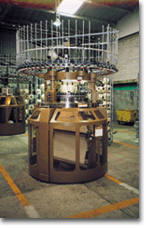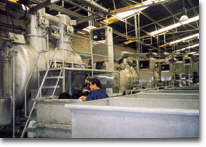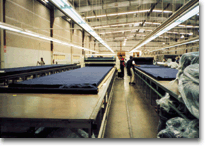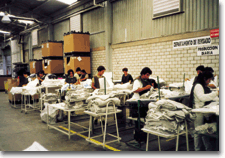A
TI recently had the opportunity to see first hand the benefits of NAFTA at Qualytel de
Puebla SA de CV, an apparel manufacturing plant in Puebla.
 According
According
to company officials, they consider themselves a NAFTA company, rather than a Mexican company. This
is a fully integrated operation that starts with the fiber and sends out the finished product to
customers.
The company makes private label T-shirts, pants and sweatshirts, exporting 100 percent of its
products. Qualytel produces between 800,000 and 1 million products each month, and reports annual
sales at approximately $50 million.
In order to maintain the high level of quality at the plant, it is frequently visited by U.S.
customs inspectors. The company consistently maintains a clean, safe work environment.
Qualytel began in 1979 as TAURO, a yarn spinning operation. In 1989 came the incorporation of
Qualytel. Today, Qualytel is comprised of 2 fabric plants that house knitting and dyeing and
finishing; and 3 garment areas that house cutting, screen printing, packing and shipping. The total
space of Qualytel’s fabric and garment areas is 211,600 square feet. The company added its own
97,900-square-foot sewing facilities in 1994.
In 1997, Qualytel opened ExporMex in Laredo, Texas, for its U.S. distribution needs.
Qualytel employs 1,080 people,
working a continuous four-shift system. According to Vincenzo Petrozzino, vice president of
technical services, the company is going to a shift system where each shift works a 12-hour day,
four days a week. A manager is on duty at all times.
From The Start
Qualytel manufactures 70 percent of
its own yarn. The remaining 30 percent is imported from Parkdale Mills Inc., Gastonia, N.C.;
Avondale Mills Inc., Sylacauga, Ala.; and Mayo Yarns Inc., Mayodan, N.C.
For its yarn, Qualytel imports cotton from Memphis, Tenn. The bales are opened in the
company’s spinning facility, 30 miles away from the main manufacturing plant. Schlafhorst equipment
is used in the opening area. The yarn in spun on machines from Marzoli and Rieter.
On The Floor
 The
The
first stop on the tour was the company’s offices. Here is where the company goes through
pre-production and design. All of the design specs are sent from customers, which include Tommy
Hilfiger, The Limited, The Gap and Old Navy. Customer service is also handled through the offices.
Walking into Qualytel’s large knitting area was quite impressive. Vice President of Textiles
David Stuart pointed out the 14 circular knitting machines by Mayer, Vanguard and Orizio Paolo
running down both sides of the large, open room, all of them fully operational.
Directly through the knitting room is the dyeing and finishing facility. The company offers
a seven-day turn around for colormatching using Datacolor International equipment.
Part of Qualytel’s state-of-the-art facility includes a complete Scholl dyehouse. They do
some roll printing in this part of the plant as well, printing fabrics for turtlenecks and other
knit shirts. Plans are also in the works for the company to add a garment dyeing facility within
the next year.
The company treats all of the water used in the dyehouse before it is released back into the
environment.
The Cutting Room Floor
 Across
Across
the parking lot is Qualytel’s cutting area. Lectra Systems dominates this area. Its equipment is
used in pattern making, digitizing, marker making, automatic cutting and spreading.
Bierrebi machines are used for die cutting.
After the apparel pieces are cut, they are shipped to Qualytel’s sewing facility. The
finished products are then returned to the main manufacturing area for screen printing. Sometimes
the pieces are screen printed before they are sewn together.
The company has four screen printing machines, all by MHM. They burn their own screens,
based on design patterns sent to them by their customers, ranging from a small Tommy Hilfiger red,
white and blue logo on the back of a T-shirt to “Old Navy” spelled out in big bold letters across
the front of a shirt.
To The Finish
After the printed products are dry,
they either go to be sewn or go to be inspected. Qualytel does a hands-on inspection of all
products that it ships out.
Products that pass inspection go to be packaged for shipping. Each product is packaged
exactly by the customer’s specifications, including the position of price tags and size stickers.
Products are then shipped out to ExporMex, where they are picked up by customers and taken
to their retail distribution centers.
Q1+1 2000 Plan
 To
To
prepare for the next millennium, Qualytel has developed a plan they call Q1+1 2000. The objectives
of this plan is to support consolidation and growth throughout the company with focus on quick
response and quality.
According to the company, Qualytel has many strengths including a high-quality product and
the right niche market. They also have a sound textile tradition and state-of-the-art machinery.
Being a NAFTA company is also an advantage, because it gives them access to commercial channels in
the NAFTA marketplace.
The company hopes to be three times as big as they are now in five years time, and will
approach European and Mexican markets.
Qualytel currently trains workers for advancement in the company. They have on-the-floor
training in a variety of jobs, including a program where a worker “shadows” a manager.
According to Javier Elenes, executive general director: “Education is an investment towards
quality.
January 2000




